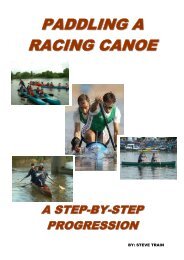The Science of Canoeing By Richard Cox
The Science of Canoeing By Richard Cox
The Science of Canoeing By Richard Cox
Create successful ePaper yourself
Turn your PDF publications into a flip-book with our unique Google optimized e-Paper software.
Since the demands <strong>of</strong> lactic training are both physiologically and psychologically exhausting they should not<br />
take place too <strong>of</strong>ten. Once a week in the specific preparatory training period (see p. 164) and 2 to 3 times per<br />
week leading up to (but not too close to) major competitions is usually sufficient<br />
Axiomatic training is used by many swimmers to develop the lactic system. This entails maximum efforts <strong>of</strong> up<br />
to 1 minute holding ones breath. This may be <strong>of</strong> some benefit to canoeists although I have still to hear <strong>of</strong> it being<br />
successfully used as a training technique in this country.<br />
To increase the speed <strong>of</strong> the recovery process following lactic acid build up and to improve the efficiency <strong>of</strong> the<br />
aerobic system, it is necessary to develop the cardiovascular respiratory system. That is, increase the supply <strong>of</strong><br />
raw materials for energy metabolism (oxygen, glycogen, fat etc.) to the muscle cells and eliminate <strong>of</strong> waste<br />
products. Before describing how this can be achieved it is necessary to understand the way the cardiovascular<br />
respiratory system works.<br />
<strong>The</strong> oxygen required for metabolism is contained in the air we breathe. When we inhale, air passes through the<br />
nose and mouth and then travels down the wind pipe which divides into two branches, each leading into two<br />
halves <strong>of</strong> the lungs. Each branch further divides into smaller and smaller branches eventually leading into tiny<br />
thin walled air sacs called alveoli. Each <strong>of</strong> these sacs is surrounded by a basketwork <strong>of</strong> very fine blood vessels<br />
known as capillaries. It is in the alveoli that oxygen diffuses through the thin walls into the bloodstream. As<br />
oxygen passes into the blood, carbon-dioxide diffuses out <strong>of</strong> the bloodstream and into the lungs for expiration.<br />
At rest we breathe about twelve times per minute, but when exercising breathing rates increase to help take in<br />
more oxygen.



